on Building EVs, Lifecycle Costs & Virtual Design in Action
Ford & GM, old & new. . .lifecycle and propulsion. . .a hybrid for the military. . .VR for design. . .from Ferraris to Greyhounds (?). . .Scion and a strong robot. . .a non-scary robot. . .advanced tech for mining. . Porsche’s honesty
Building EVs: Two Approaches
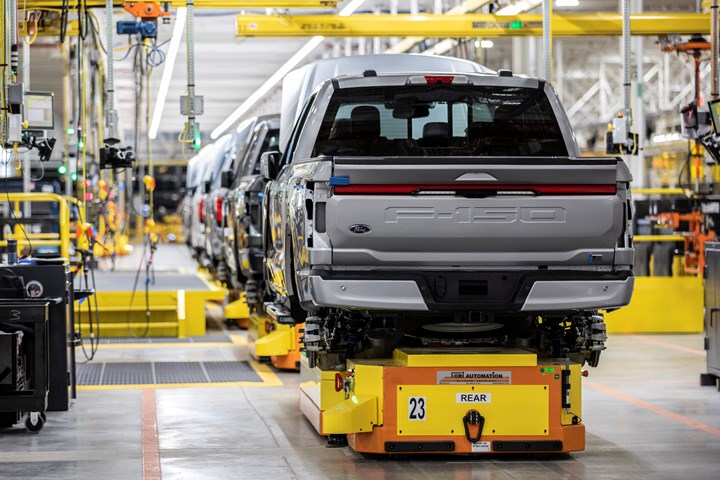
Building Lightnings in Dearborn. (Image: Ford)
Last fall, Ford announced that it is investing $5.6-billion in Stanton, Tennessee, to establish BlueOval City, “a vertically integrated ecosystem for Ford to assemble an expanded lineup of electric F-Series vehicles and will include a BlueOval SK battery plant.”
In September 2020 Ford announced an investment of $700-million to build the Rouge Electric Vehicle Center for F-150 Lightning production at the massive complex in Dearborn complex; it is to fully launch this spring.
Last week GM announced that in order to produce more electric vehicles it is investing $4 billion in its Orion Assembly Plant in Michigan to produce the Chevrolet Silverado EV and electric GMC Sierra.
GM has converted Detroit-Hamtramck Assembly (a.k.a., the “Poletown Plant”) into Factory ZERO and Spring Hill Assembly (once upon a time the “Saturn Plant”) for electric vehicle production in the U.S.
One Way & Another
Ford is, in effect, building new plants while GM is retrofitting old.
While it is one thing to look at the $6.3-billion Ford is investing in new assembly plants as impressive in and of itself--
and it is
--it led me to wonder about its other U.S. assembly plants.
When did they go into production?
- Chicago Assembly, 1924
- Dearborn Truck, 2004
- Flat Rock Assembly, 1987
- Kansas City Assembly, 1951*
- Kentucky Truck, 1969
- Louisville Assembly, 1955
- Michigan Assembly, 1957
- Ohio Assembly, 1974
To be sure, all these plants have been the recipients of significant investments over the years.
Still, one could make the argument that it is due time for a new plant.
In case you’re wondering about the timing of the GM plants that are being or have been retrofitted and retooled:
- Detroit-Hamtramck, 1985
- Orion Assembly, 1983
- Spring Hill, 1990
*Ford is producing the e-Transit at Kansas City, so it isn’t just going all-new for EV assembly.
///
Life Cycle & Ownership Costs: ICE v. BEV
Say you’re presented with a study titled “Life Cycle Analysis Comparison: Electric and Internal Combustion Engine Vehicles.”
And it was produced by an organization named “The Fuels Institute.”
What do you think it will say?
- Gasoline vehicles are best
- Hybrid vehicles (which use an internal combustion engine) are best
- Battery electric vehicles are best
{Pause}
[Full disclosure: Based on “The Fuels Institute” moniker, my answer to the question was. . .incorrect.]
- Life cycle winner is the battery electric vehicle (BEVs).
And not by a little.
The study, conducted by Ricardo Strategic Consulting, which looks at both life cycle emissions and total cost of ownership, found that after 19,000 miles of operation the BEV is less carbon intensive than ICE vehicles.
But let’s face it: Many people, environmental concerns notwithstanding, are probably more pocketbook-driven.
Which is where the BEV really comes in to its own.
The analysis considers a 10-year ownership period.
Here’s how it breaks down.
ICE Vehicle
- Capital cost: $27,044
- Insurance cost: $13,434
- Fuel costs: $19,643
- Maintenance/repair: $21,459
- Total: $81, 581
Battery Electric Vehicle*
- Capital cost: $35,758
- Insurance cost: $15,971
- Fuel costs: $5,198
- Maintenance/repair: $13,529
- Total: $70,457
So that’s about a 15% delta with the advantage to the BEV.
By the way: Hybrids do better than straight ICE vehicles, too, with the total coming in at $74,618 compared to the $81,581.
Lesson: Don’t let an organization’s name bias your point of view.
And know that according to The Fuels Institute: “We consider ‘fuel’ to be any type of energy being used to power a vehicle, and our research encompasses a breadth of issues affecting the vehicles and fuels markets.” Not just liquids.
*Battery replacement costs are not included. But it is worth noting that were you to buy, say, a Hyundai IONIQ EV, you get a 10-year battery warranty so that’s not an issue. A Mustang Mach-E battery is warranted for 8 years or 100,000 miles. In other words, warranties that are very ICE powertrain-like.
///
Oshkosh’s Tactical Hybrid

Hybrids running on electricity only can be. . .quiet. (Image: Oshkosh)
Last November the U.S. Army Contracting Command – Detroit Arsenal (ACC-DTA) awarded Oshkosh Defense with an order for 1,669 Joint Light Tactical Vehicles (JLTVs), as well as 868 trailers and some other gear.
Oshkosh Defense has been building the JLTVs since 2015 when it first got a contract from the military.
Ahead of the Game
“While the U.S. Army has not requested a hybrid-electric JLTV as part of the JLTV recompete, the eJLTV proves that Oshkosh Defense has the team and technical capabilities to produce this highly capable vehicle today,” said John Bryant, Executive Vice President for Oshkosh Corporation and President of Oshkosh Defense.
The U.S. Army is going to “recompete” the program for light-duty vehicles and then issue a follow-on contract in September 2022. . .a contract valued at $6.5-billion.
So perhaps anticipating the way the future will likely unfold, Oshkosh has developed a hybrid version of the truck.
The Vehicle
The hybrid, according to an Oshkosh Defense spokesperson, adds an “integrated motor generator and a high voltage energy storage system” to the engine and transmission that are used on the non-hybrid version. This means a 6.6-liter turbodiesel and a six speed. There is a 30 kWh lithium ion battery on board.
Benefits to the military include the ability to run silently (as that image up there emphasizes), a fuel economy improvement of more than 20%, and export power capacity of up to 115 kW from the truck so there isn’t a need to tow a generator.
Clearly, the folks at Oshkosh Defense are well aware of the bias toward alternative powertrains in Washington right now, so. . . .
///
Drawing While Waving Your Arms Around
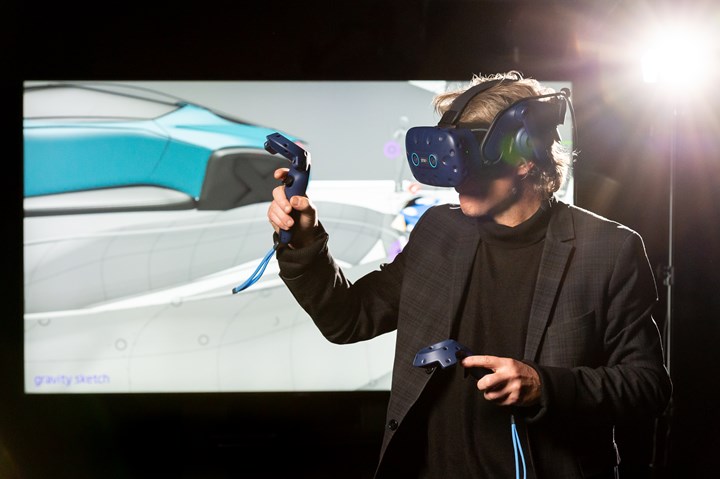
Designing in the metaverse for the realverse. (Image: Renault)
Renault designers are embracing the use of virtual reality gear in order to perform “3D sketching.”
One of the benefits of using a VR headset and controllers on the ends of one’s arms is speed in developing and sharing sketches (i.e., with an internet connection there can be collaboration between designers who are similarly outfitted, and with an audio headset they can converse as they sketch).
Says Hischke Udo, a chief designer at Renault, "It takes at least four weeks to run a scan or data file through a machine, while everything here is in real time. That's a huge advantage."
The tech facilitates everything from homing in on specific details to creating 1:1 vehicle designs.
Better Be Fit
But here’s something that more conventional sketching—be it on paper or a tablet—doesn’t necessitate: “Drawing in 360° means you have to be in good shape and take breaks every hour,” says Udo.
Seems that eye strain, headaches, and back and joint pain can kick in after prolonged use.
Don’t try it at home.
///
Pininfarina Designs a. . . Bus
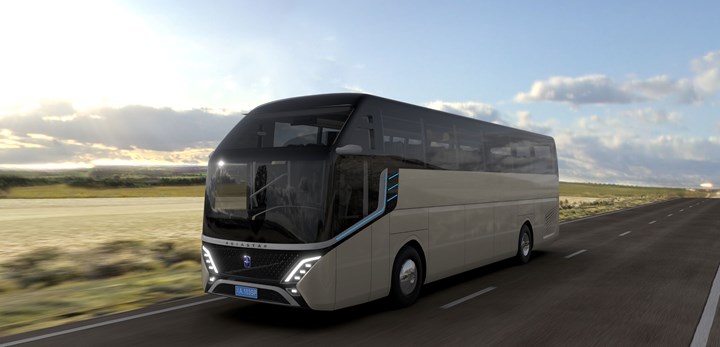
Not your typical tourist hauler. (Image: Pininfarina)
Speaking of design. . .
Buses don’t get quite the level of love in the U.S. as they do in other parts of the world, especially those that are used for tourist applications.
Tell a neighbor you’re going to be taking a bus trip to a neighboring state and they’ll wonder whether you’ve fallen on hard times or have an AARP membership.
In other parts of the world, mass transit is simply a reasonable alternative.
Case in Point
Consider the just-introduced X9-3 from ASIASTAR, a Chinese company that’s been building buses for more than 60 years.
"This new bus is targeted at the domestic high-end tourism market and overseas high-end market, and represents a brand new platform for ASIASTAR Bus' high-end tourism buses,” said Jia Kaiqian, general manager of ASIASTAR.
The X9-3, interior and exterior, was designed by Pininfarina.
Most of the vehicles seen in the U.S. designed by Pininfarina are ones most of us can’t afford (Ferrari 458 Italia, Ferrari FF. . .).
A bus. Go figure.
///
Throwback Scion and Contemporary Fanuc
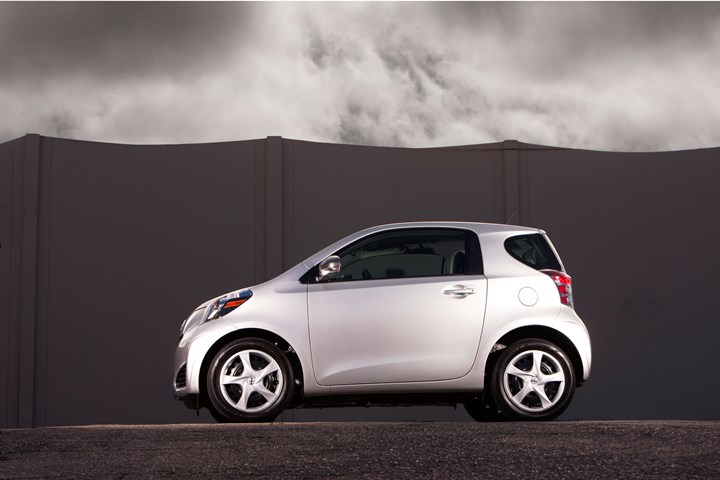
The Scion iQ, circa 2011. You could lift it with a robot. The whole thing. And then move it more than 10 feet. (Image: Toyota)
Remember the Scion iQ, the diminutive four-seater that is 120.1 inches long, 66.1 inches wide and 59.1 inches high? The car launched in 2011 that was alleged to be capable of handling four passengers?
(Fun fact: Back in 2011, Aston Martin, purveyor of James Bond-like vehicles, determined it was going to have a bit of bother meeting 2012 EU fleet emissions regulations. So the company came up with a plan to sell a car named the Cygnet in the U.K. And the Cygnet was a modified version of the Scion iQ. One thing that wasn’t changed: the 1.3-liter, 94-hp powertrain. The Cygnet had a run of two years. According to carsalesbase.com, Aston sold a total 593 Cygnets from 2011 to 2014. Perhaps that £32,000 sticker had something to do with it.)
Why interest in the iQ? Well, a number caught my eye.
Fanuc introduced a new robot, the M-1000iA. The robot has a wrist payload of 1,000 kg, or 2,204 pounds.
Curb weight of a Scion iQ?
2,127 pounds.
And think about this:
The M-1000iA has a maximum reach of 3,253 mm (10.67 feet).
It has a repeatability of 0.1 mm.
That is about the thickness of a dollar bill. (Back when the iQ launched the base MSRP required 15,265 of said bills.)
So were you to have an M-1000iA and a Scion iQ, you could use one to move the other.
///
Spot and Stretch

The platform travels and the robot reaches. (Image: Boston Dynamics)
Speaking of robots. . .
You’ve undoubtedly seen at least one YouTube video of a Boston Dynamics Spot robot dog (or a pack of them) that evokes a sense of unease.
Spot is a bona-fide robotic device that can be used in a variety of applications ranging from security to inspection.
But still. . .
Anyway, Boston Dynamics is now part of Hyundai. And Spot has been joined by Stretch, this a (somewhat) more conventional robotic seven-degree-of-freedom arm that is mounted on a mobile base so that it can move about the environment.
One application of Stretch is material handling.
The first commercial customer for the robot is DHL Supply Chain, which has signed a multi-year, $15-million investment with Boston Dynamics that includes Stretch models that will be used to automate unloading in distribution centers, starting with trucks, then used for other warehouse tasks.
Implementation starts this spring, then there will be a rollout over the next three years.
Stretch features a computer vision system that allows it to ID boxes without preprogramming. It can also work autonomously in situations where there are fallen boxes or disordered stacking configurations.
And as it doesn’t have legs like Spot, it is less unsettling.
///
Auto Innovation and Iron Ore
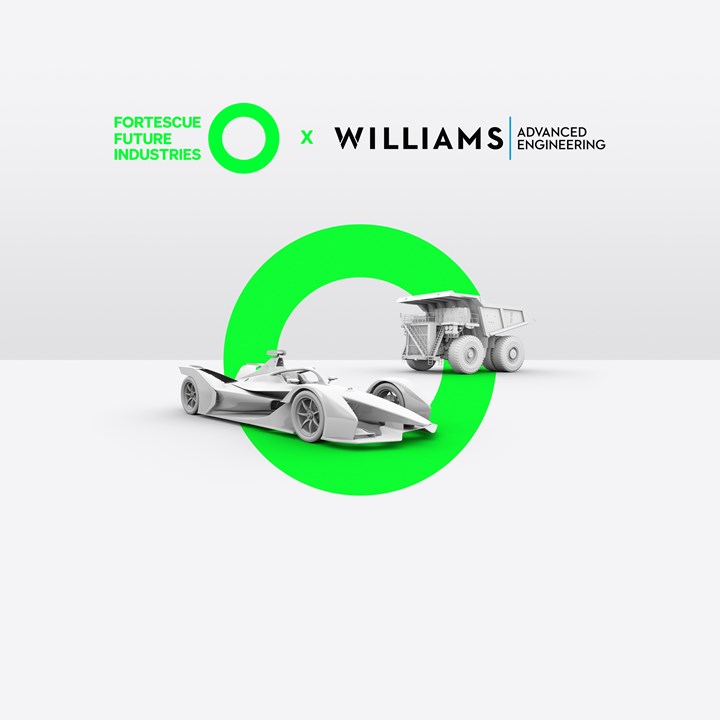
Race cars meet ore haulers. (Image: WAE)
Williams Advanced Engineering (WAE) was rolled out of Williams Grand Prix Engineering, with the “Williams” as in Sir Frank Williams, the Formula One driver and subsequent team owner.
WAE has evolved into a company that is deeply involved in battery and electrification tech and product development.
Simply: a very advanced tech firm with roots in transportation (well, to the extent that F1 racing falls under that category).
And this is how the world is changing:
WAE has been acquired by Fortescue Metals Group (FMG).
FMG has an iron ore business that includes “integrated mining, rail, shipping and marketing teams working together to export over 180 million tonnes of iron ore annually.”
A mining company.
However, FMG established FFI, or Fortescue Future Industries.
FFI is FMG’s “100 per cent renewable green energy and industry company”:
“FFI is establishing a global portfolio of renewable green hydrogen and green ammonia projects with a target to supply 15 million tonnes per year of renewable green hydrogen by 2030, rising to 50 million tonnes per year in the decade thereafter.”
In making the announcement of its acquisition, WAE noted:
“WAE will bring its race bred critical battery technology to FFI, which will in turn enable Fortescue, one of the largest iron ore producers in the world and a heavy carbon emitter, to realise its industry leading 2030 net-zero target. This will be achieved by working together to help bring green energy to life in programmes such as Fortescue’s 3 km long freight trains, 400 tonne haul trucks and industrial heavy mobile equipment.”
Think about it: This is a mining company that has acquired one of the most innovative automotive technology companies because, as Dr. Andrew Forrest, FMG founder and chairman puts it:
“This is the race of our lifetimes - the race to save the planet from cooking. The speed at which we move matters. Together FFI and WAE will work to decarbonise Fortescue – with the aim of achieving that faster and more effectively than anyone else in the world.”
There’s a lesson there.
///
Most Honest Headline Ever (Not Including This One)
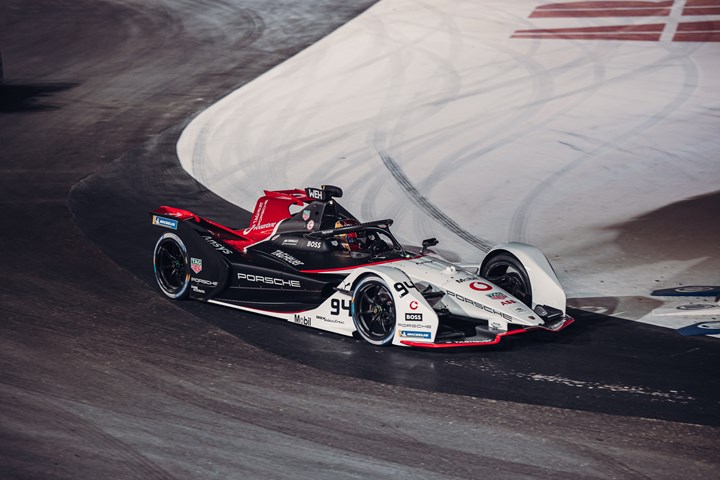
Porsche is now in its third season of Formula E racing. (Image: Porsche)
OEMs have a tendency, when it comes to things that are quantifiable and not in their favor, to put a spin on the headline for the announcement.
So full marks to Porsche in reporting the results of the first race of season 8 of the ABB FIA World Championship that was held this past weekend in Saudi Arabia:
Zero points for Porsche at the Formula E season-opener
No spin there.
Porsche is campaigning two 99X electric vehicles in the series.
The race was a double-header.
The headline for race two was a bit more centrifugal:
Porsche narrowly misses first podium of the season
Driver André Lotterer finished fourth, 1.125 seconds behind the winner.
Not that narrow.
RELATED CONTENT
-
On Military Trucks, Euro Car Sales, Mazda Drops and More
Did you know Mack is making military dump trucks from commercial vehicles or that Ford tied with Daimler in Euro vehicle sales or the Mazda6 is soon to be a thing of the past or Alexa can be more readily integrated or about Honda’s new EV strategy? All that and more are found here.
-
Frito-Lay, Transportation and the Environment
Addressing greenhouse gas reduction in the snack food supply chain
-
Aluminum Sheet for EV Battery Enclosure
As the number of electric vehicles (EVs) is about to increase almost exponentially, aluminum supplier Novelis is preparing to provide customers with protective solutions


.jpg;width=70;height=70;mode=crop)






